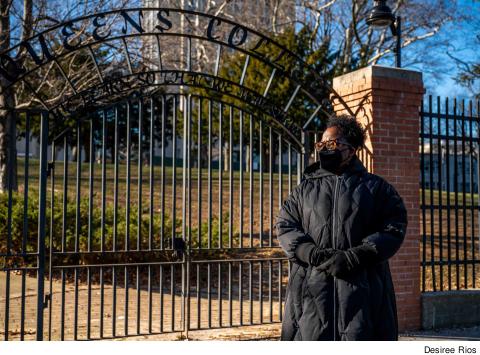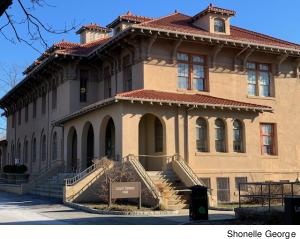A Queens College safe space targeted
 |
On January 6, a swastika and the words “KKK LIVES” were found carved onto a public bulletin board at Queens College (QC). The antisemitic, anti-Black graffiti appeared inside Delany Hall on the one-year anniversary of the failed insurrection at the United States Capitol, where far-right protesters and paramilitary organizations violently attempted to overturn the results of the 2020 presidential election and keep then-President Donald Trump in office.
The QC incident is just one of many across the country as racist and antisemitic acts targeting Jewish, Black and immigrant communities increase nationwide. Delany Hall may have been targeted because it is the first building at Queens College to be named after a Black faculty member. It is home to the Africana studies department, QC’s higher education access program SEEK (Search for Education, Elevation and Knowledge), and the Center for Ethnic, Racial and Religious Understanding (CERRU).
As Queens College activists noted, the very existence of Delany Hall is a hard-fought victory in the movement. It is a physical space where students of color can congregate and meet with faculty and staff, a place where students can hold open dialogues about racial and ethnic issues on campus. They say it is the very heart of multicultural scholarship and activity at Queens College.
INITIAL SHOCK
“My first reaction when I found out about it was shock, but [I] also just [felt] very upset, overwhelmed, confused, angry and, I think, overall, like I didn’t belong anymore,” said Allyson Regis, a SEEK counselor who works in Delany. “The building is kind of like a safe haven for students, faculty and staff, and so it felt very targeted. I felt like I wasn’t sure how to process it for a while, because it felt like home – like your home – was under attack.”
The next day, Queens College President Frank Wu sent a short letter to the college community, reporting the “discovery in recent days of offensive and hurtful graffiti in Delany Hall.” The letter continued, “Anyone who feels endangered or believes their rights have been violated should immediately notify Public Safety.”
For many campus activists, especially faculty and staff who work at Delany Hall, the tepid nature of the administration’s response only added to the feeling of injury. David Gerwin, the Queens College PSC chapter chair, said that the incident and the administration’s response has sparked campus organizing to demand greater attention to racial justice issues at the college.
“It might be time to shine a light on hate at Queens and publicize this and really get some resources to try to solve the particular crime. [We] also [need to] talk about funding operations on campus and the kind [of] security support that would make Delany feel safe,” Gerwin said.
Faculty and staff at Queens College sent a letter to Wu in response to his initial statement, in which they asked the college to:
- Address the emotional and psychological impacts the incident has caused the residents of Delany Hall.
- Provide a detailed timeline of the investigation along with specifics on what steps will be taken and by whom.
- Provide specifics on protective measures to be implemented for Delany Hall’s residents and premises, including the artwork donated by renowned BIPOC artists to the SEEK Program that is currently displayed on all three floors of the building.
- Establish a committee to develop a zero-tolerance policy at QC with member selection oversight by a collective that includes minoritized students, faculty and staff, and include punitive actions to be given for violations of said policy.
ADMINISTRATION RESPONSE
 |
The letter stated, “Delany was believed to be a sacred place of communing, learning, gathering and healing. The blatant violation of this in the form of white supremacist messaging has left building occupants feeling unsafe and unprotected.”
The letter also noted that the most recent incident at Delany didn’t take place in a vacuum. It cited the 2013 surveillance of CUNY Muslim students and a swastika etched on a campus bathroom stall in March of 2020, among several other racist incidents in and around Queens College.
“There is a concern of a culture of impunity of racialized, antisemitic and Islamophobic violence,” said Aysa Gray, associate director of CERRU. “We want to see this be different than those instances. This can’t continue. We want this to be a shift in the landscape of this issue. We’re hoping to push past performativity.”
As the Queens community began to express their frustration, the college administration issued a statement on January 14 that said they were working with both CUNY security and the NYPD to investigate the incident, saying that the campus was also “strengthening the training of Public Safety officers on how to respond to hate.”
The administration followed up with another message to the community with information about counseling services for those who might need them in light of the hate incident.
In a January 26 email, Gerwin told members that Wu had responded to faculty and staff concerns. “President Wu has offered concern, but nothing specific about his investigation, no immediate and dramatic security presence, and no targeted funds to the programs in Delany for the kind of programming and academic response that they could offer with such support.”
The incident has, indeed, shaken many who work in the building. Sophia McGee, the director of CERRU, told Clarion, “I’ve never felt unsafe in there before this moment, and now I feel unsafe,” adding that it has forced her to consider the prospect of a violent attack at work. “How would I get out?” she wondered.
Such fears come from a heightened climate of fear in January, a month in which an Asian woman was pushed onto the subway tracks in Manhattan and four synagogue congregants were held hostage in Texas. It’s a context that has given the vandalism a deadly seriousness and it has had a direct impact on the work environment in the building.
Norka Blackman-Richards, director of the college’s SEEK Program, said the fear among workers in the building is palpable. “People are in distress,” she said of her fellow workers. “I have parents of staff asking me about their child. It’s a serious concern for us.”
Natanya Duncan, the director of the college’s Africana studies program, works in an office near the entrance of the building, a fact that has made her consider her own safety. At the same time, she believes the faculty and staff need to stay united against fear and hate.
“We don’t want to be intimidated out of the building,” Duncan said. “The atmosphere of impunity, the lack of speedy and concise and clear and spelled-out processes and repercussion for this kind of behavior continues. As a result, it contributes to the level of uncertainty that we have about our own safety and the physical space itself. We cannot ignore the history and richness of the building and its contents. This is about an affront to the physical building and the artwork and the spirits that still walk those halls [and] have served as guideposts to persons of color, not just the students, of all levels on campus.”
FEAR AT WORK
Queens College faculty and staff who spoke to Clarion said they hoped that the college administration would work with them on not just addressing safety at the building, but ensuring that there is no longer a culture of impunity on campus.
The PSC’s top officers and the union’s Anti-Racism Committee endorsed the faculty letter, saying in a statement to Wu, “[W]e agree with the Queens faculty and staff who are looking for ‘more than words’ from you. The Queens administration must respond with the necessary resources and a comprehensive plan to address the following needs of the community.”
The PSC principal officers and the PSC Anti-Racism Committee co-chairs wrote a joint letter to CUNY Chancellor Félix Matos Rodríguez and Wu, demanding “the development of a CUNY Central anti-racist response team composed of faculty, staff and students, so that these situations are not isolated and institutional responses are therefore not limited to the judgment of individual administrators” and calling for the “identification, protection and construction of safer spaces.”

